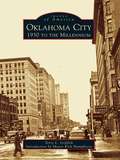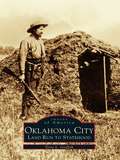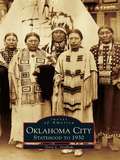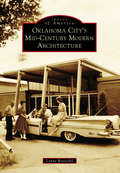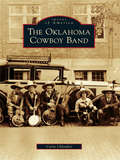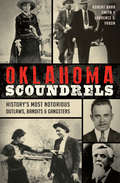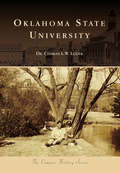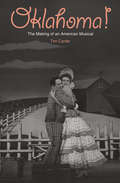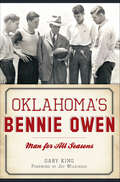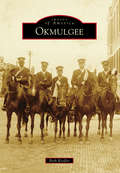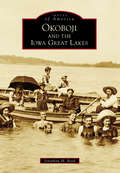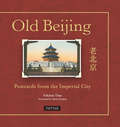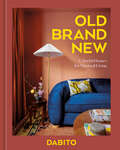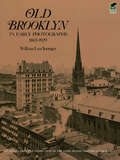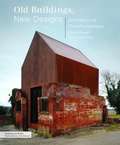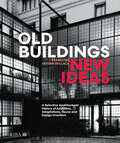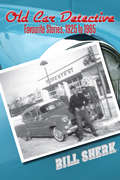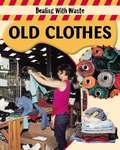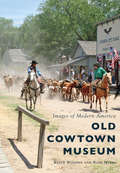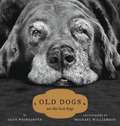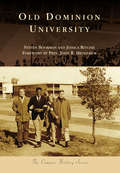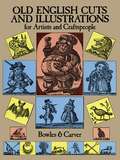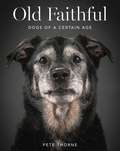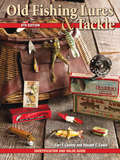- Table View
- List View
Oklahoma City: 1930 to the Millennium
by Terry L. Griffith Mayor Kirk HumphreysSince this wild frontier land was settled at the bang of a gun one April morning, Oklahoma City has grown rapidly, experiencing some of the most drastic changes of all over the past century. Many of the photographs in this new volume show construction anddevelopment as the city began to truly prosper,--downtown skyscrapers and modern highways, museums such as the Cowboy Hall of Fame and the Kirkpatrick Planetarium, and major plants operated by GeneralMotors and Dayton Tire & Rubber Company. Recent images highlight celebrations, including high school football games, outings to Bricktown and Myriad Botanical Gardens, and finally, Opening Night 2000.
Oklahoma City: Land Run to Statehood
by Terry L. GriffithLocated along the Atchison, Topeka & Santa Fe Railroad, at a stop known as Oklahoma Station, Oklahoma City was born on April 22, 1889, at 12 noon. By 6:00 p.m., she had a population of around 10,000 citizens. As with any birth, there were many firsts in the newly opened territory, and many of these landmark events have been captured and preserved in historic photographs. With images culled from the archives of the author,'s own vast personal collection as well as the Oklahoma Historical Society and other collections, the stories of prosperity and development of the area,'s first settlers are told through Statehood. In light of this perseverance, it is no wonder that Theodore Roosevelt announced, ,"Men and Women of Oklahoma. I was never in your country until last night, but I feel at home here. I am blood of your blood, and bone of your bone, and I am bound to some of you, and to your sons, by the strongest ties that can bind one man to another.,"
Oklahoma City: Statehood to 1930
by Terry L. GriffithThe first session of the 59th Congress introduced theconsideration of the statehood bill, providing for the admission of two states: one to be composed of the Indian and Oklahoma Territories, and the other formed by uniting Arizona and New Mexico Territories. The Omnibus Statehood Bill became law on June 14, 1906. On the morning of November 16, 1907, more than 10,000 residents from Oklahoma Citytraveled to Guthrie to celebrate their recently won statehood. Using over 200 images combined with well-documented facts from city directories, newspapers, and first-hand accounts, this book chronicles Oklahoma City,'s unique history from its beginnings in the early 20th century as Packingtown to theDepression Era. Also featured are many glimpses into the city,'s everyday past,--scenes of residents enjoying a day at Belle Isle, the State Fair, and on the streets of downtown,--and a section on Henry Samuel Overholser, the Father of Oklahoma City.
Oklahoma City’s Mid-Century Modern Architecture (Images of America)
by Lynne RostochilFrom its very first land run days in 1889, Oklahoma City has been a mecca for daring men and women intent on transforming the flat, grassy prairie into a thoroughly modern metropolis. This risk-taking ethic came to beautiful fruition after World War II when several enterprising young architects, many of whom were students of the mighty Bruce Goff at the University of Oklahoma, rejected traditional styles and approaches and enthusiastically embraced more modern forms in their sleek, ambitious building designs. The result is a vast collection of bold mid-century modern structures that span every function and budget, from the giant egg-shaped First Christian Church to the modest but equally dramatic Neptune Subs building to homes like the spiral-shaped Zuhdi House. This book celebrates Oklahoma City�s unique built landscape and the minds behind our best architectural treasures.
Oklahoma Cowboy Band, The (Images of America)
by Carla ChlouberThe Oklahoma Cowboy Band was the first western string band in the nation to broadcast over the radio and appear on vaudeville, drawing large audiences throughout the Midwest and Northeast. The band began in Ripley as Billy McGinty's Cowboy Band and first played over radio station KFRU in Bristow in May 1925. Billy McGinty was a Rough Rider with Theodore Roosevelt and performed in Buffalo Bill's Wild West Show. The public responded to the broadcast of his band with a steady stream of telegrams, telephone calls, and letters asking for more of that old-time cowboy music. Soon Otto Gray and his wife, Mommie, of Stillwater joined the band, with both performing rope tricks, Mommie singing sad songs, and their son, Owen, performing comedy routines as "the Uke Buster." Renamed Otto Gray and His Oklahoma Cowboys, the band traveled for a decade to such cities as St. Louis, Chicago, Cincinnati, Indianapolis, Pittsburgh, and Syracuse. Its custom-built Cadillacs drew crowds wherever the band went. By the early 1930s, other acts were copying the band's cowboy themes and songs, and Otto Gray's lawyers threatened legal action. The lawyers met with only limited success, though, and today the cowboy image is firmly established in country music, thanks in large part to the early success of Billy McGinty, Otto Gray, and the Oklahoma Cowboy Band.
Oklahoma Scoundrels: History’s Most Notorious Outlaws, Bandits & Gangsters (True Crime)
by Robert Barr Smith Laurence J. YadonEarly Oklahoma was a haven for violent outlaws and a death trap for deputy U.S. marshals. The infamous Doolin gang's OK Hotel gunfight left five dead. Killers like Bible-quoting choir leader Deacon Jim Miller wreaked havoc. Gunslinger femme fatale Belle Starr specialized in horse theft. Wannabe outlaws like Al Jennings traded train robbing for politics and Hollywood films. And Elmer McCurdy's determination and inept skill earned him a carnival slot and the nickname "the Bandit Who Wouldn't Give Up." Historians Robert Barr Smith and Laurence J. Yadon dispel myths surrounding some of the most significant lawbreakers in Sooner history.
Oklahoma State University (Campus History)
by Dr Charles LeiderOklahoma State University was founded in 1889--18 years before statehood--as Oklahoma A&M College (OAMC), under the Morrill Land Grant Acts that allowed for the creation of land grant colleges. By midcentury, OAMC had a statewide presence with five campuses and a public educational system established to improve the lives of people in Oklahoma, the nation, and the world by adhering to its land grant mission of high-quality teaching, research, and outreach. On July 1, 1957, Oklahoma A&M College became Oklahoma State University (OSU). With more than 350 undergraduate and graduate degrees, OSU and its nine different colleges provide an unmatched diversity of academic offerings. Today, OSU has students enrolled from all 50 states and nearly 120 nations. There are more than 200,000 OSU alumni throughout the world.
Oklahoma!: The Making of an American Musical (Broadway Legacies Ser.)
by Tim CarterThe backstage story of the timeless Broadway hit, and how Rodgers and Hammerstein brought it to life: &“Meticulously researched&” (Publishers Weekly). Oklahoma! premiered on Broadway in 1943 under the auspices of the Theatre Guild, and today it is performed more frequently than any other Rodgers and Hammerstein musical. In this book, Tim Carter offers the first fully documented history of the making of this celebrated American musical. Drawing on research from rare theater archives, manuscripts, journalism, and other sources, Carter records every step in the development of Oklahoma! The book is filled with rich and fascinating details about how Rodgers and Hammerstein first came together, the casting process, how Agnes de Mille became the show&’s choreographer, and the drafts and revisions that ultimately gave the musical its final shape. Carter also shows the lofty aspirations of both the creators and producers and the mythmaking that surrounded Oklahoma! from its very inception, and demonstrates just what made it part of its times.
Oklahoma's Bennie Owen: Man for All Seasons (Sports)
by Gary KingBefore Bob and Barry, even before Bud, there was Bennie, and he might have been the best of them all. He was certainly the most innovative. Best remembered as the mentor of the University of Oklahoma's football team from 1905 through 1926, Bennie Owen also coached baseball and basketball and served as the director of athletics. He retired as intramural director at the age of seventy-five. A visionary and a builder, he exerted the driving force that created the university's Memorial Stadium, one field house, Memorial Union building, men's swimming pool, baseball field and bleachers, concrete tennis courts, nine-hole golf course and intramural playing fields. A true man of all seasons, he laid the foundation for a Sooner tradition of excellence--in football and beyond.
Okmulgee (Images of America)
by Beth KiefferIn 1868, the Muscogee (Creek) Nation confirmed its constitution and established Okmulgee, which means "bubbling waters," as its capital. After a grueling journey on the Trail of Tears, they settled in the Okmulgee area. Many brought their slaves, who would later join the tribe as freedmen after the Civil War and form the beginnings of a thriving African American community. As Okmulgee grew, white traders and settlers arrived in the burgeoning town. A post office was established, and in 1900 the Frisco Railroad line was built. By 1907, statehood loomed and oil fields dotted the landscape. This boom would continue until the Great Depression. World War II brought the construction of the Glennan Military Hospital, which cared for American service members and German prisoners of war from Oklahoma prison camps. Okmulgee's interesting cultural history continues to be preserved today.
Okoboji and the Iowa Great Lakes (Images of America)
by Jonathan M. ReedGeneration after generation, families of vacationers have returned to northwestern Iowa’s Okoboji and the Iowa Great Lakes for summertime rest and recreation. From the earliest pioneer days to the Spirit Lake Massacre to the first rustic outdoorsmen’s accommodations, this deep glacial lake and its sister prairie lakes have been embraced by visitors for more than 150 years. Slow growing until rail service in 1882, the area saw investment in the form of the Orleans, the grandest hotel west of the Mississippi, which was demolished a scant 15 years later. By then, though, word had gotten out, and Lake Okoboji’s wooded bluffs and sandy beaches became places of quiet repose for vacationers. Resorts of all sizes drew the wealthy and modest alike. Among the area’s attractions were Arnolds Park Amusement Park; the Roof Garden; the Casino, Central, and Inn ballrooms; thrilling boat rides; skating; and summertime “bathing” in the revitalizing waters. Now largely given over to private residences of all sizes, the many marinas and public areas still draw summertime visitors intent on forging their own indelible memories.
Old Beijing
by Susan Naquin Felicitas TitusCamel trains arriving at a city gate; the distinctive architecture of the Forbidden City, its pagodas, imperial buildings and temples; Manchu fashion, the Empress Dowager and the child emperor Puyi; street performers and foreign tourists-all come to life again in this extraordinary collection of rare and vintage postcards. Old Beijing: Postcards from the Imperial City offers a unique look at a vanished China and its storied capital. Comprising 350 black-and-white and hand-tinted cards that span the period from the last years of Imperial China to the Japanese invasion of 1937, it is a treasure trove for historians, collectors, Sinophiles, and anyone fascinated by people and cultures from times past.
Old Beijing
by Susan Naquin Felicitas TitusCamel trains arriving at a city gate; the distinctive architecture of the Forbidden City, its pagodas, imperial buildings and temples; Manchu fashion, the Empress Dowager and the child emperor Puyi; street performers and foreign tourists-all come to life again in this extraordinary collection of rare and vintage postcards. Old Beijing: Postcards from the Imperial City offers a unique look at a vanished China and its storied capital. Comprising 350 black-and-white and hand-tinted cards that span the period from the last years of Imperial China to the Japanese invasion of 1937, it is a treasure trove for historians, collectors, Sinophiles, and anyone fascinated by people and cultures from times past.
Old Brand New: Colorful Homes for Maximal Living [An Interior Design Book]
by DabitoNATIONAL BESTSELLER • A deeply personal and compassionate look at home ownership and rentership through more than 50 rooms designed by interior designer, photographer, and Instagram star Dabito. &“Dabito&’s work is sculptural and beautiful—everything feels like an art piece! It is elevated yet functional—my fave combo.&”—Jessica AlbaDesigner, photographer, artist, blogger, and passionate vintage hunter Dabito is beloved on social media for his creative use of color, space, and maximalist design style. Old Brand New offers readers actionable advice to layer spaces with meaning through refreshing décor and bold hues, whether you&’re signing a lease or renovating or buying your first home. Illustrated with photographs of Dabito&’s many design projects and inspiring snaps from his travels, this book&’s chapters are each supplemented with how-to guides for weekend-friendly projects large and small. He includes helpful advice on hanging a gallery wall to styling bookshelves, repurposing furniture, and designing a vacation-inspired outdoor patio space. Along with easy daylong projects, Dabito also tackles deep renovations, with his down-to-the-studs ADU (accessory dwelling unit) project in Los Angeles where he changed an awkward laundry and storage room into his dream guest house. The power color alchemist also provides failproof color palettes for achieving a cohesive color story in your own space.In this deeply personal book, Dabito draws on his family&’s immigrant experiences to discuss the challenges he&’s faced finding a sense of security through designing his personal surroundings. Providing a new perspective on homeownership and rentership, Dabito reaches and empowers readers who rarely feel spoken to. Through his love of design, color, and maximalism, Dabito offers much-needed insight to the value of home and the meaning of family.
Old Brooklyn in Early Photographs, 1865-1929
by William Lee Younger157 photographs, many never before reprinted, show the vitality and variety of old Brooklyn, Manhattan's first suburb: waterfront, Brooklyn Bridge, Fulton Street, Brooklyn Heights, Ebbets Field, Luna Park, Gravesend Race Track, Sheepshead Bay, Manhattan Beach Hotel, and more from the Long Island Historical Society collection.
Old Buildings, New Designs
by Charles BlosziesThe 2008 global recession and the nearly universal awareness of significant climate change have begun to alter architectural thinking. Even though architects will continue to dream up seemingly function-free building forms for the most conspicuous consumers, mainstream architects are being asked to provide energy efficient, cost-driven forms that also delight the eye. The movement to preserve and reuse existing structures has gained momentum, and the incidence of new and old architectural juxtapositions has increased. Forward-thinking planners are advocating m ore concentrated urban density, in part to decrease inefficient use of energy for transportation. As this thinking becomes public policy, architects will be challenged to adapt historically significant buildings for new uses, often by creating additions to existing forms. Although not entirely new, architectural dilemmas concerning how new meets old will occur revealing issues that most architects w ho design new buildings have not often thought about. Historic preservationists and sustainability advocates seem to concentrate solely on single issues leading to aesthetically clumsy architecture while agency review panels and the public approval process continue to erode the integrity of building designs making the creation of truly excellent designs difficult. Reclaimed Buildings: New Meets Old explores these topics in depth, with a focus on architectural design. The book addresses the question of aesthetic sustainability given the new influences and design tools that have emerged during the first decade of the 21st century. It is written for practitioners as well as students of architecture, and includes examples and case studies of built works that have successfully wrestled with the question of how new meets old in architecture.
Old Buildings, New Ideas: A Selective Architectural History of Additions, Adaptations, Reuse and Design Invention
by Françoise Astorg BollackSome architectural transformations are modest, some are revolutionary. Shining a light on the hidden side of the accepted narrative of the history of architecture, this book explores works which transform existing buildings to build a way forward, through adaptations, additions and visual shifts. Examining 30 buildings across Europe, North America and South America, spanning from the early Middle Ages to the end of the 20th century, it demonstrates the creative possibilities of working with existing buildings. The book reveals how formal inventions can shape architecture and our environment over time in a built world constantly in a state of becoming. As we face a climate emergency, it taps into our deep cultural knowledge about the inventive use and re-use of buildings. Generously illustrated with architectural plans and over 300 colour images, it provides an alternative to the dominant view which sees conservation and preservation of historic buildings as a 20th century creation.
Old Car Detective: Favourite Stories, 1925 to 1965
by Bill SherkIn this hilarious collection of old car stories, Canada’s very own "Old Car Detective" Bill Sherk presents 80 of his favourite stories from all 10 provinces, spanning the years from 1925 to 1965. In this book you will meet the man in New Brunswick who chopped the top off his 1927 Whippet sedan in honour of the coronation of Queen Elizabeth II; the young fellow from Kingston, Ontario, who thought his 1937 Ford coach looked better with all four fenders taken off; the owner of a 1947 Hudson that burned so much oil he had to wear a snorkel mask while driving it; the father who borrowed his son’s hot-rodded ’53 Monarch (built only in Canada!) and got pulled over by the police for street racing; and the grandmother who moved from England to Canada and drove her Morris Minor on the wrong side of the road. Behind every old car there’s a story waiting to be told, all the way from your grandparents’ Model T Ford to the Mustang you drove in high school. All the stories and photographs in this book are in chronological order from 1925 to 1965, giving you a 40-year journey through Canada’s rich automotive heritage and brought to life by the people who owned and drove the cars of yesteryear – and some still do! PART ONE (1925 to 1942) takes you from the middle of the Roaring Twenties to February 1942, when the Second World War brought automobile production to a halt for three long years. PART TWO (1946 to 1965) takes you through the Baby Boom years when cars driven by Canadians went through many exciting changes in styling and engineering. If you have ever owned (or still own) a car that was built between 1925 and 1965, turn to the last page in this book to see how you can send in your story for Bill Sherk’s next book.
Old Clothes (Dealing with Waste)
by Sally MorganDealing With Waste: Waste is a huge problem. Trash cans overflow with garbage, old cars and refrigerators are dumped in the countryside, and food is wasted every day, even though many people are hungry. Dealing With Waste explains how you can reduce, reuse, and recycle to tackle the problem of waste. Learn why the planet is becoming full of unnecessary waste--and see what you can do to make a difference. Old Clothes: * Why does making clothes harm the environment? * Which clothes are needed the most following a natural disaster? * How are secondhand clothes turned into designer clothes?
Old Cowtown Museum (Images of Modern America)
by Keith Wondra Barb MyersOld Cowtown Museum originally started as a shrine to the pioneers and founders of Wichita. It later reinvented itself according to Hollywood�s version of the Old West. After the peak of Western films, the museum once again updated its theme to reflect Wichita�s agricultural history. In recent years, Old Cowtown Museum has become a nationally recognized and accredited living history museum. A product of 1950s Old West nostalgia, it has become one of the most beloved of all of Wichita�s museums and institutions. Inside this book is the story of how Old Cowtown Museum became the regional and cultural attraction it is today, along with images of the museum throughout its 66-year history, including people, events, and stories, many of which have never been published before.
Old Dogs
by Gene Weingarten Michael S. WilliamsonAnyone who has ever loved an old dog will love Old Dogs. In this collection of profiles and photographs, Weingarten and Williamson document the unique appeal of man's best friend in his or her last, and best, years. This book is a tribute to every dog who has made it to that time of life when the hearing and eyesight begin to go, when the step becomes uncertain, but when other, richer traits ripen and coalesce. It is when a dog attains a special sort of dignity and a charm all his own. If you've known a favorite old dog, you'll find him or her on these pages. Your dog might go by a different name and have a different shape, but you'll recognize him or her by the look in an eye or the contours of a life story. There is the dog who thinks he is a house cat; the herder, the fetcher, the punk and the peacock, the escape artist, the demolition artist, the patrician, the lovable lout, the amiable dope, the laughable clown, the schemer, the singer, the daredevil, the diplomat, the politician, the gourmand, and the thief. Plus, as a special bonus, you will find the first Latvian elkhounds ever photographed. Old Dogs is a glorious gift book and a fitting tribute to that one dog you can't ever forget.
Old Dominion University (Campus History)
by Steven Bookman Jessica Ritchie President John BroderickThe story of Old Dominion University began during one of the most uncertain times in American history. In 1930, as the country sank deeper into the Great Depression, the College of William and Mary opened a two-year extension school in nearby Norfolk, Virginia, to provide affordable, quality education to the community. Embracing its founding spirit of innovation, the school rapidly evolved into an independent, four-year college and adopted Virginia’s nickname “Old Dominion.” As the country transformed during the 1960s, so did the college, and by 1969, it had progressed into a dynamic public university. Now with over 250 academic programs, nine colleges, and approximately 25,000 students representing over 100 countries, Old Dominion University continues to pride itself on forward-thinking research, inclusiveness, and strategic partnerships.
Old English Cuts and Illustrations: for Artists and Craftspeople (Dover Pictorial Archive)
by Carver BowlesA rich source of striking imagery, this compilation of 163 black-and-white prints was reproduced from a rare collection of 18th-century broadsides. Illustrations include folkloric characters (Peggy Bacon-face, Bet Boozer, Sir John Falstaff) as well as animals, ships, soldiers, traditional English heroes and members of the royal family, and other distinctive graphics.
Old Faithful: Dogs of a Certain Age
by Pete ThorneOld Faithful is a striking and heartrending collection of photographs and stories featuring dogs who are well worn, well loved, and well on in years. The Old Faithful Project started after photographer Pete Thorne snapped photographs for his grandmother's hundredth birthday party. Inspired, he began photographing elderly dogs. What he discovered were faces with more life, more joy, and more wisdom than he could have ever anticipated.After he posted a few photographs, stories and pictures came pouring in from around the globe--people wanted to share tales of their own senior dogs. Thorne met with hundreds of senior dogs and their best friends and human companions. Old Faithful features seventy-five of these dogs and their stories.Each dog has a different background. Some were rescued from pet mills, like seventeen-year-old Chihuahua Sam, who has exceeded his life expectancy by five years and counting. Some needed a forever home after their owners could no longer care for them, like sixteen-year-old toy poodle Grimm, who's had a long list of health problems but remains as unique and lovable as ever. And some have been companions since puppyhood, like ten-year-old rottweiler Brut, who loves his human siblings as if he were their mother. But all of these dogs are beloved, in their own patchy, scruffy, jowly glory.
Old Fishing Lures & Tackle: Identification and Value Guide
by Carl F. Luckey"The long-awaited 8th edition of Old Fishing Lures & Tackle -"the bible for lures collectors"- has been thoroughly updated, combining the time-honored research of the late Carl F. Luckey with essential updates from author Russell E. Lewis. It now features:More than 2,000 photos include hundreds of new lures.Among the 5,000 listings is fresh information on related categories like rods, reels, creels and ephemera.A new section on "recent sales" charts the continued strength of the hobby based on solid auction results."This book continues to be a must-have resource for any serious collector."-Recommended by AntiqueFishingLures.com"
